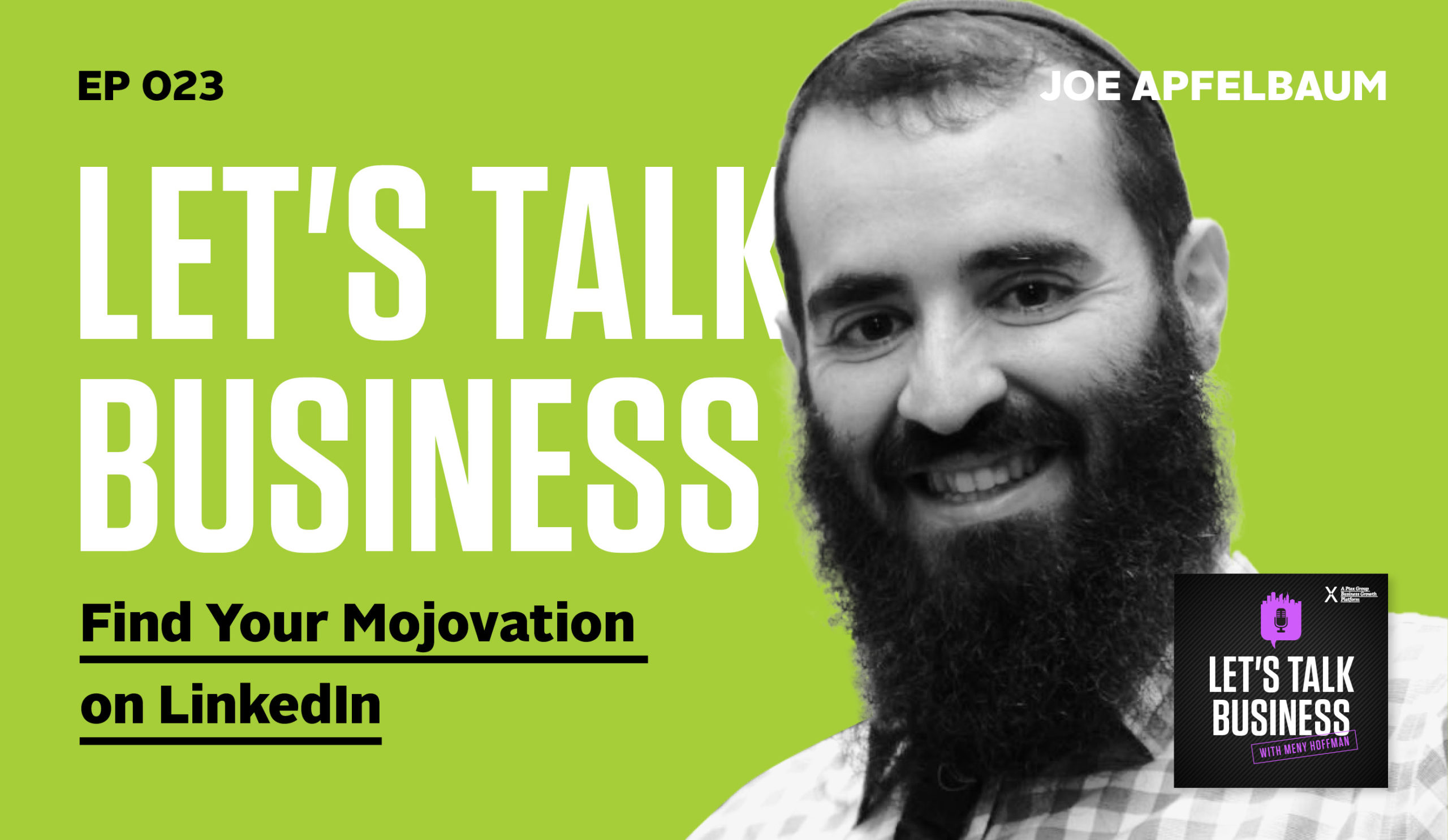Did you know that you can use your financial statements to optimize your workflow?
I am excited to share my interview with Neville Joffe, a world-renowned educator on the topic of financial literacy. With over 25 years of international business experience, he has trained more than 20,000 executives and managers around the globe. He is also the author of the best-selling book, The Baker’s Dozen Rules of Highly Successful Business Operators.
In our interview, Neville demonstrates the power of financial literacy by sharing how he took a company that was on the brink of bankruptcy and turned it around, and how you can use those same concepts to grow and scale your business. Neville explains why it is absolutely critical to use your financial numbers to educate your team and make them more accountable. Pay close attention to how Neville outlines key financial data that is essential for you to know to be a successful leader. Without further ado, here is my interview.
Listen to the podcast here:
Download the audio file here.
Inspire Team Accountability Through Financial Literacy—with Neville Joffe
—
Neville, thank you for joining me.
You’re welcome.
You and I have known each other for quite a while now being a part of a mastermind together and we ended up speaking where you shared with me part of your life story. What’s fascinating is obviously you’re all about teaching teams in the corporate world about financial literacy, but what fascinated me is the story and how you got to this. For our readers, I want you to start with that story that will put the proper foundation for our conversation.
I am from South Africa originally. I was imported from South Africa to Canada to restructure a vertical manufacturing company. Meaning it’s fully integrated, produce our own raw materials to finished product. We had about 400 unionized employees, historically very profitable, but then got into some financial challenges. Some of the readers may recall that in the early ‘90s, we had gotten to NAFTA, which is North American Free Trade, which put a big challenge onto pricing in North America. We were in double-digit inflation, mortgages running at 12%, 13%, 14%. It was hugely problematic in keeping the manufacturing sector afloat. I have a philosophy that nobody washes a rental car, which has no sense of ownership. During those times, it was hard to negotiate with a union.
I said to them, “I can assign the deal that you ask me to renegotiate the union agreement, but I’ll guarantee you we’ll be out of business within a year.” With that thought in mind of driving profitability, I managed to secure a three-year wage freeze in support of a profit share program. I needed our people to feel a sense of ownership. I have to admit it was very tough. My partner, who was a founder of the company, a generation older than myself, was vehemently against financial transparency. A clash, but eventually I managed to persuade him we needed to do that. I tried traditional ways of teaching business literacy. I needed people to understand the financial implications of the decisions and how the decisions would positively impact the profits of the business together with their pockets.
I tried the traditional way of teaching this. I used my internal accounts to teach business. It was a dismal failure because understanding accounting and teaching to non-financial people are two different skills. I then called in a college prof. It was simply the wrong thing more efficiently. I had to keep him on steroids. I thought, “This is not working.” I realized we could scrape the profits off the floor. There were so many opportunities. I just needed our people to get engaged and understand where these what I called hidden pockets of profit lie. I was desperate and I was losing credibility with a union. I was losing credibility with my partner and he kept saying, “I told you. They didn’t need to do what we tell them.”
What I did was I cashed $1,000 in small bills and I crumbled them up into black garbage bags. I’ll call a meeting with my partner and his family who were the owners of the business. I will say I had some shares in the business, the union, and all the staff. We had to visualize this. We had 400 people standing there. I stood in the back of the factory. I had some pre-labeled buckets all covered up and I shook the cash-out. I say, “This is called revenue.” Everyone looked at me aghast. They couldn’t believe, like, “What?” I watched all this cash floating. It looked like a fortune. I took handfuls of cash and I put them into pre-labeled buckets called fabric, labor, rents, process. I had some $20 bills in my pockets. I started tearing them up and I put them in a bucket called waste. I heard everyone freaking out. I said, “Why are you guys freaking out? You do this every day.” I did tape them together again afterward.

I love that because you visually brought it in front of their face in order to have a good, healthy conversation.
It was tactile. They could relate to it and the cash is left on the table. I sit and I cut their pile in half. I said, “This half is for the owners of that company for the risk that we take. The other half is for all of you to share equally with each other.” Equally being the operative term. Let me explain this. I had some people working in the office who are salary people who said, “Neville, this is not fair. Why people in management or people in the office earning, let’s say, for example, $60,000 a year, why should they get exactly the same bonus as people on the shop floor earning $30,000 a year?”
I said, “Here’s why. I pay you a salary for your skill, but I pay you a bonus for your heart and soul. I have a real moral issue paying somebody who’s getting $60,000, who comes to work and do what they need to do and go home, paying them more than somebody on the shop floor earning less money who always has to work on time, never complains, always off to do more, always coming up with new ideas. Why should they get less than somebody else who does the bare minimum? I’m going to treat all of you like equal shareholders and the bonus that we share equally between all of you, I’m going to consider like a dividend. You’re all equal shareholders.”
I did pay supervisors who people have the responsibility and put more. They came out of the company’s half, not out of the employee’s half. There was no conflict of interest. It was remarkably successful. I started using unorthodox ways of teaching. I changed my KPIs, my key performance indicators, and simple metrics. Within three years after starting that initiative, which was my seventh year in the company, it was so successful. This company had zero long-term debt. It was bearing debt that we had before, which was an operating line. I sold my interest back to the original owner. It was remarkably successful.
[bctt tweet=”Pay a salary for someone’s skill, but give a bonus for their heart and soul.” username=””]
If you have to capture what happened, is it that sense of ownership that the rest of the team got? Is it the incentive? How would you rate the reason for turning that around?
Yes, to all of those questions. Here’s what happened. Number one, people work better with meaningful incentives. Number two, this is a power of engagement. We found acres of diamonds of skillsets amongst our factory workers that I would never have thought possible because we engaged them in conversation. We gave them meaningful incentives. We respected their opinion. As owners, we cannot do this alone. There are so many entrepreneurs who want to grow their businesses, but they can’t do it alone. I was one of them. They are the bottleneck in the process. You need to engage your employees to help you grow, but you’ve got to give them an incentive that goes with it. That’s essentially what I did. That was the success of the business.
Let’s dive into this conversation. This is important and you touched a little bit upon it when you said, as you were starting to implement it in that business, which is there are both sides of the aisle. There’s the ownership that says, “Let’s keep the financial part of the business separate and not so transparent.” There is also the other side of the aisle, which the employee said, “That’s why you’re the business owner. You guys figure it out financially. I am here to do a task, do a role, and do a job.” How do you basically bring those two together?
I call it the 20-60-20 rule. Twenty percent of your work population, like with anybody who is a student or your work population, no matter what you do, will not get it. They’re resistant to the norm. They’re plodding along and do the bare minimum. You get 20% on the top. No matter what you do, they get it and run with the baton. They take whatever you tell them, any new information, they’re hungry for information and they grow. They are your champions. You get 60% in the middle that you’re trying to influence. You can never make everybody happy. You’ve got to go according to what you totally believe in as an owner of a business. I believe that if you embrace philosophy or a culture of engagement and education, then you can hold them accountable. The word profit is not a four-letter word.
When people say, “Look how much money the company’s making.” That’s true. Would you rather work for a company that loses that shirt every month that makes you vulnerable, that you may lose your job, or would you rather work for a successful company where you are secured to get your pay every month? Which one would you rather work for? In answer to your question, there’s a delicate balance and you spoke about financial transparency and showing not everything interesting is useful. A measure of transparency is a measure of sharing that information that people can control, that they can understand. That’s where education comes in and reward them for that success, giving them a feeling of belonging or belongingness.
I know that this is also a highly discussed topic in your book. Obviously, also when you teach the concept of top-line revenue versus profits. Especially now with technology companies growing top-line revenue and there’s a huge push from entrepreneurs to on the top line revenue number. There is some sense to it, which is you cannot arrive at the destination of profits without the top-line number. What is the proper balance for business owners to look at those metrics?
Chapter seven of my book, the title is Revenues are Vanity, Profits are Sanity and Cashflow is Reality. I’ve heard people say that business is very simple, to sell it more than it cost you, give or take a few thousand details. In answer to that question, it’s all a balance. Of course, revenues are important, but so are costs. If you have no costs, you cannot possibly have any revenues. It’s the relationship between and cost. Part of our teaching is to create context around costs and the relationship of how much revenue should you generate to cover your costs and make a profit. Everybody should understand this, and this gets into a deep dive. Understanding the power of customer mix. Not all revenues are made equal.
Salespeople and business owners don’t understand the financial side of the business. They think they do, but when the rubber hits the road, they don’t really. They say, “All my revenues are up.” Chapter three of my book says, “So what?” Your revenues up. What is your product mix? How much are your margins? How many resources do you need to support this? How much revenue must you generate when you step up our cost? Most people don’t know the answer to these things. Yes, revenues are important. Of course, they are. Costs are important because, without them, you wouldn’t have revenues. It’s understanding the relationship between these two that can help people measure and manage profitability.

One thing that stood out when we spoke last and you shared with me some of those quizzes that you deal with hundreds of thousands of key level executives within large companies. Obviously, the numbers don’t look that good. What will be one of those metrics that stood out of businesspeople that make decisions for large companies and not even aware of those numbers and what those mean?
I do a number of presentations to executive groups. I’ve done this for many years. I’ve discovered that the average level of financial literacy, I’m talking about it at a basic level, is less than 40%. These are people who are making million-dollar decisions. Some of them are publicly traded companies and entrepreneurs or growing companies. When the rubber hits the road and asks him what’s the role of a P&L or a balance sheet, most of them get it wrong. I ask people, “When you pay for your debt, what happens to your net worth?” Do you know that most people will tell you that your net worth goes up when you pay off your debt? It’s simply not true. Your cash goes down, your debt goes down, your net worth doesn’t change, yet most people will answer to the contrary. These are basic concepts people need to understand to help them make fiscally responsible decisions.
Let me ask you about that. For our readers probably saying, “I have my accountant for that. I have my bookkeeper for that. I’m here to make decisions about building the company.” Where does this affect decision-making?
Number one, bookkeepers, for the most part, are financially illiterate. I’ve taught thousands of them. They are very good bookkeepers and great at making sure your taxes are paid on time, on allocating transactions, but their role is not to produce financial statements that help the owner of the business manage the business. Not to say that all of them are like this, but I can tell you, the majority are like that because that’s not their job. They’re not trained to do this. By the time the accountants come in to do your end, it’s way too late. Financial statements relate to a current or historical event. They’re not about future events. When a business operator is making financial decisions, they need to have the frame of reference and the knowledge in order to anticipate what their financial statements are likely going to look like given certain decisions in helping them forecast the future.
The financial statement is your business scorecard. Imagine playing a game of hockey and not understand the scorecard. It would be outrageous, but in a business, your financial statements are your scorecard. Here’s an example. I’m going to discount my product. I’ll sell my product for $100, it cost me $60. I make $40 a unit. If I discount by 10%, how much more volume must I sell? I’m going to answer this in two parts. The answer is, the discount is 10%. Your new gross profit is 30%, which means you’ve got to increase your volume output by 33% to make the same amount of profit. Most people I’ve asked don’t have a clue that he’s even a computation for this. The second question I would ask if I was a business operator is, my revenue will go up, my margins will drop. Do I have enough cashflow to support the additional volume? Do I have enough people to secure the additional volume? If I were to hire more people, how much more volume must I sell? These are questions that are never asked by business operators or very rarely. I need to visualize this through a set of financial statements. I can make a prudent decision. I’m giving you one example of hundreds.
[bctt tweet=”Your financial statement is your business school card.” username=””]
I remember a couple of years ago, I was speaking to a business owner that was running a company for two years growing top line, as we call them. We had a conversation that he’s not making money that he can’t even pay himself. I was going through some of the information with him. He was confusing profit margins with markup, not understanding how to calculate. When I asked him, “How do you mark up your products?” He gave me that number. Ultimately, when it came down to margins, the margins were way slimmer.
It’s because of basic trade math. It’s a skill that a lot of people don’t have. On that topic, what I advocate is it’s only a question of having the right answers. It’s a question of people asking the right questions. A lot of people are not math smart. I see this all the time. People say, “I’m not a numbers person.” I respect that. I’m okay with that. There are lots of people around who can help them with the numbers, but you need to be able to ask the right questions, and not having a math mind is okay. I deal with tons of people who are incredibly smart. These people could be doctors, lawyers, professionals, HR professionals, artists, and people in the arts, whatever. They’re very smart people and yet they have no idea about numbers. Conversely, I deal with hundreds of engineers who are math smart and have no idea. They don’t have a brain that’s wired for business.
For our readers saying, “I need to get a little bit more involved. I need to know what those numbers mean.” What would be some first to the third step they could start doing? Where would the focus be first?
The first thing you need is to understand how your financial statements work. It does not mean you have to do your own financial statements. It’s not about that. In fact, it’s not your job. You need to understand the role of your P&L, the role of your balance sheet, understand cashflow, how all these relate to each other. It’s not as difficult as people make it out to be. I’ve taught this for many years. I’ve educated more than 20,000 people. I promise you, it’s not as tough as people make it out to be. They make a big deal of it. Growing entrepreneurs in particular or scaling entrepreneurs need to understand the story behind the numbers. That’s the very first thing they need to do. Otherwise, I cannot have a knowledge-based discussion with their bookkeepers or accountants and I cannot manage expectations.

As far as key performance indicators, those are the stuff. You got to know what you’re looking for, but then what would be those metrics that you would say every business owner should at least keep the finger on the pulse as far as sustainability in cashflow?
I’ll speak to you in principle because the actual specific metrics and KPIs depend largely on the type of business. You will have a different metric in the manufacturing industry and you work in construction versus services. Here are the general thoughts. Number one, the fewer, the better. Not everything interesting is useful. People come up with all kinds of numbers and I covered these in my book in these various chapters. Also, what gets measured gets managed. Throwing out a million different numbers doesn’t mean it’s going to move the needle. You get swamped with numbers. It’s like a thermometer. It tells you the temperature of your business. Choose those numbers that are meaningful to you that are an indicator of success.
Don’t get overwhelmed with too much information. We tend to drive too much information, which can often cause a problem because we’re driving the wrong behaviors. The second big one I want to talk about here. It’s also a chapter of my book. Don’t evaluate numbers in isolation. Be very careful of numbers in isolation. I can prove that revenues can go up revenue and gross profit can go up and you can lose your shirt. Why? It’s because your step-up costs are going up too much or you think revenues are up. My net profit is up, but you’re running out of cash. You’ve got to be very careful about looking at numbers in isolation, per se. Any KPI or metrics depends on how one looks. The term is an essential user. It’s the same for the purpose of this discussion. Make sure that all the indicators touch on profitability, cashflow, and all the components in between. Looking at revenues is a great indicator, but you cannot look at it in isolation. You’ve got to look at the related costs and the related cashflow and the and the potential resources needed to grow. Your KPIs or your ratios need to address all the various touchpoints that could positively or negatively impact your business performance.
[bctt tweet=”Not everything interesting is useful.” username=””]
We started doing our 2021 planning and we were looking at what we call scorecard numbers, which is obviously the key performance indicators. Whenever we came up with those metrics, we always asked ourselves, “If we track this number, will we know what to do if those numbers are not giving us the results we looking for?”
Can you connect them to operating behavior? If not, cut it out. It’s also a question. If you want to engage your employees in this process, you want to make sure that whatever numbers you present to your employees, they’ve got about control it. There’s no point in saying operating profits, which includes rent, includes your accounting fees, includes your professional fees. It’s not fair to your employees that you expect them to control operating profits if you throw a whole lot of non-controllable costs into the pot. When you create your metrics to whatever, make sure that if you share these numbers with your employees, I encourage you to do so, otherwise, you are asking them to work blind. It’s simply not fair. Make sure that you can control that number.
You’re showing them numbers that if the numbers are not giving us the results we’re looking for, they know, “I could tighten the way I approach projects. I could tighten my labor cost,” whatever it is. Bring it up and change those numbers because otherwise, they’re looking at a bunch of numbers, and then it becomes almost like a weekly thing. We’re looking at numbers, but nobody’s doing anything because of that.
If they can control it, you give them an incentive and you give them the license to think, you’ll be absolutely amazed how they will come up with new ways of doing things. When I ask people, “Why do you do X, Y, and Z?” The worst words I can ever hear is, “Because we’ve always done it like that.” It’s the worst thing I can ever hear. What worked for you 1 or 2 years ago doesn’t mean it works for you now. Look at COVID now. Certain systems that work pre-COVID will certainly not work. There are lots of these examples. Businesses have changed because of this.
Meaning to say, it goes both ways. When I spoke on this topic many times in the past when somebody will come over and say, “If we’d done it and it’s working, then, of course, you could continue doing it.” Don’t be afraid of questioning at least.
Chapter twelve of my book says, “Don’t do the wrong thing more efficiently.” We tend to keep wanting to improve our systems as they are. Now we need your question should we even be doing that? This is the way they’re going to find tons of what I call the hidden pockets of profits. The hidden pockets of profits are when you started reassessing. Employees help you with that.

I want to ask you one more question, which is a little bit deviating from the core, but obviously very important on this topic, which is where does accountability come into play? You could see a lot of companies making financial plans, projections, forecasts, and all of those, but they somehow don’t know how to connect that to accountability with the people on the ground. What would be that process? Could you shed some light as far as how those two dots connect?
Here’s my full process. The reason why we’re in business is to drive profits and sustainable cashflow. The word sustainable is the operative word because anybody can cut costs right now and show a great profit. Look what’s going to happen in the next period when you’ve got no staff left. That’s not the long-term answer. In order to drive sustainable profits and cashflow, which is a reason why you’re in business, number one, you need to engage your employees. You need to educate them. If you do that, you can then hold them accountable. It’s not reasonable to hold people accountable for non-performance if you don’t engage them in the process of decision-making and educate them. I believe that if you have people in your employ and you pay them $20,000, $30,000, $40,000, $100,000 a year, whatever you’re paying them, you’re paying them because you are trusting them to deliver what they promise. Would that be a fair statement?
Absolutely.
If you’re going to pay somebody, you are trusting them that they’re going to behave responsibly. They’re going to do what they said they’re going to do. They’re going to make fiscally responsible decisions. They’re going to be open and honest with you and your customers. That’s the ideal employee. You can teach competence, but you cannot teach attitude. You can influence to some extent, but you want to make sure the attitude of your employees have integrity. It’s reasonable then to expect a business operator owner to hold people accountable if they don’t do what they say they’re going to do. You said you would provide the sample to the customer by Friday. You didn’t do it.
This is expensive to an organization with larger credibility and a whole lot of other issues that arise from non-performance. Somebody is going to be held accountable. Somebody is representing your organization should be accountable for good behavior and bad behavior. When you engage all your employees as part of your culture where everybody’s making decisions and a particular individual in the organization is not delivering what they said they would deliver, the team has to hold this person accountable. It was affecting everybody.
The word accountability, in my view, embraces everybody. Everybody is accountable. You need a transparent environment in order to bring non-performance to the surface in a positive way so we can correct the behavior by educating them, demonstrating the implications of non-performance. Ultimately, if they’re going to move on, they’re going to move on. We, as owners, are accountable to the bank. We’re accountable sometimes to unions. we’re accountable to our shareholders. We’re accountable to our employees. Aren’t we as owners accountable, Meny?
Yes.
Why shouldn’t everybody else in the company is accountable? Here’s a thought for you. Your employees are the custodians of your company’s profits. I’ve done presentations to senior executives and companies and asked them, “How many people have signing power on your bank account?” I go around the room and people put up a 1 finger, 2 fingers, 3 fingers. I said, “You’re all wrong because everybody has signing power on your bank account.” They all look at me with this crease on the foreheads. “What are you talking about?”
Here’s what I meant. By the time you signed that check, it’s too late. Your employees are making decisions that impact what you pay out your bank account. They are a direct extension of that pen that is signing their check. They are therefore accountable for making decisions that impact your bank balance and they are accountable to your shareholders, whether it be you alone or outside shareholders. They are accountable for making decisions.
[bctt tweet=”Engage and educate your employees. If you do that, you can hold them accountable.” username=””]
This is a great way of ending this because sometimes you don’t connect those dots. You have a company and you have an organization having different sets of meetings in different parts of the company. Ultimately, if they don’t connect, you’re not getting the proper results. I also want to add a very important point that was discussed throughout, but it’s important for our readers to grasp, which is when it comes to financial numbers, it’s never the exciting part. Marketing, sales, new clients are all exciting parts and shiny objects versus bookkeeping, accounting margins and reporting. These are usually never exciting. However, I will tell you that if you are measuring the right metrics and seeing the progress, it’s pretty damn exciting.
It brings life to the numbers. The number is an indication of success or failure. They represent the numbers.
You also, at that point, decide it’s worth what we’re doing. We’re seeing the progress and we’re seeing it in the bottom line. We’re seeing it with cashflow. Ultimately, putting aside the passion and excitement of doing what you’re doing, you want it to be sustainable. That’s what you need.
Can I share something with the readers? There is a gentleman who is standing on the side of the road and he’s got a dog sitting next to him. He’s standing up and his dog is sitting down and his dog is howling in pain. Somebody walks past and said to the gentlemen, “What’s the matter with your dog? He’s howling in pain.” He said, “I know.” He said, “What’s going on?” He said, “He’s sitting on a nail.” “He’s sitting on a nail? Why doesn’t your dog get up?” His response was, “It’s not painful enough.” My message to the readers is don’t wait for the pain.
When your accountant or your bank manager calls you to say you don’t have money in your account, your shareholders or your financial statements represent said, “You lost money.” “Yes, but my revenues are up.” “Yes, but you lose your shirt.” Don’t wait for the pain. Be proactive. You need to get a grip on your financial statements. You need to get your people engaged to help you make prudent decisions. You need to be ahead of the game. There should be no surprises in your business. You should know exactly what the outcome is likely going to be if you understand the financial implications of decisions. It’s not only you. This is what everybody in the company who’s representing your checkbook.

Let’s close with four rapid-fire questions. Number one, a book that changed your life.
Quantum Leap Thinking, James Mapes was good.
Number two, a piece of advice you got that you’ll never forget.
Know your numbers.
Number three, anything you wish you could go back and do differently?
I will stop trying for perfection and keep moving on and keep adjusting as you learn. Learn with your staff. It’s a learning process for everybody.
We always say, “Don’t let perfection get in the way of progress.” Number four and final question, what’s still on your bucket list to achieve?
Legacy. I’m in my 60s already. In my role now, I have been through several companies and had been very privileged to benefit dramatically through successes and failures. I want to leave a legacy with as many listeners and as many people who can participate with me. If I can influence the lives by understanding that power or business literacy and sharing with your employees and growing together, then I believe I’ve done my job on earth from a commercial perspective.
Neville, thank you for joining us. I know your time is valuable. That is why in the name of our readers, we will forever be grateful for sharing some of your time with us.
It was my pleasure too. Thank you.
Links Mentioned:
- The Baker’s Dozen Rules of Highly Successful Business Operators
- Neville Joffe – LinkedIn
- Quantum Leap Thinking
About Neville Joffe
 Neville is regarded as a world authority on the subject of bridging the gap between corporate financial goals and employee performance. With over 25 years of International Business experience, Neville has trained more than 20,000 Business Executives & Managers internationally, with many of the world’s leading companies such as Hallmark Cards, Campbell Soup, Burger King, Constellation Brands, Toyota, Bombardier, and more. He also trains various government sectors, non-profit organizations, and boards of directors.
Neville is regarded as a world authority on the subject of bridging the gap between corporate financial goals and employee performance. With over 25 years of International Business experience, Neville has trained more than 20,000 Business Executives & Managers internationally, with many of the world’s leading companies such as Hallmark Cards, Campbell Soup, Burger King, Constellation Brands, Toyota, Bombardier, and more. He also trains various government sectors, non-profit organizations, and boards of directors.
Neville is a sought after public speaker and has been featured in various news publications and industry-specific newspapers. He has written and published several textbooks that accompany his patented teaching method for use in community colleges and universities, and is also the author of the acclaimed book, “The Bakers Dozen Rules of Highly Successful Business Operators.”









